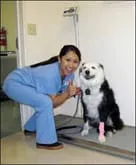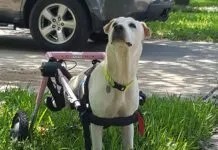We arrive at the veterinary clinic at 7:45 AM. Daisy leaps out of the car and heads for the grass in front of the door; after a long squat, she makes a beeline for the entrance, pulling me behind her. It’s always at this point I watch carefully to see if I can observe any signs of distress or apprehension about this almost weekly visit.

Instead, she is excited about going in to seeing her buddies; if I were a betting person, I would put money on the notion that she enjoys these outings. She greets the staff at the front desk and then waits not so patiently beside me as I complete her chemotherapy intake form. I have a pre-printed list of her medications that I attach to the form and note by hand if there are any changes in her health. After a few minutes, one of the oncology technicians arrives to escort her to the back; they greet each other like old friends.
I walk part way with her and then watch her happily trot off away from me, down the corridors she has come to know by heart. She turns and glances back; I think this is more for me than for her as I leave her for the day.

Her kind veterinary team at Sage Centers for Veterinary Specialty and Emergency Care in Concord let me observe Daisy’s day, so I know what happens after she disappears from sight. She knows the routine by heart: she’ll round the corner and step on the scale for her weigh in; she then pulls the technician to her next stop, the blood draw area. One technician holds her while another quickly draws the sample that will determine if she can receive her chemotherapy treatment that day. While the sample runs, Daisy is taken to her kennel, where she’ll spend the time in between treatments. Yes, her kennel. She knows which one is hers and apparently gets disconcerted if another animal needs it on her day. There’s comfort in familiarity.

The results from the blood work indicate that Daisy is good to go with the administration of her chemotherapy agents. She’s receiving a combination therapy of two drugs. The first one will be given during the morning, and the second in the afternoon, at least two hours later. When it’s her turn, one of technicians leashes her and releases her from her kennel. Daisy leads her down the hallway to the chemotherapy administration room. There are two technicians who will perform the administration and they are both covered in protective gear. It is a reminder that these are hazardous chemicals being handled.

The technicians devote their full attention to my girl. One holds her gently while the other shaves a small patch of fur from her front leg; this is down low, near her paw. The administration site will rotate each time from leg to leg. An intravenous catheter is inserted into her vein and secured with vet wrap. This will be used for the administration of both drugs, along with a drug transfer device called a PhaSeal system, which is used to contain and administer the toxic agent. Daisy relishes the attention and often attempts to give hugs or ask for tummy rubs while receiving her treatment.
During her stay, Daisy is examined by her oncologist, who reviews her blood work, completes a physical examination, and performs an ultrasound (more tummy rubs). In between her treatments and checks, she spends the day observing the hustle and bustle of the backroom from her prime viewing spot. I like to think of it as her spa day with special attention being given every step of the way in an effort to help her maintain her health.

I arrive to pick my girl up around 5 PM on the days of her treatment. Daisy’s team is notified and I wait to hear the clickety-clack of her nails on the tile as she leads the technician to the reception area. She’s happy to see me, as I am her. Her attention turns quickly to the reception desk and the bowl of treats. My consummate counter- surfer stands up and not so gently touches the bowl with her paw to indicate she wants a treat. She charms the front assistants into responding to her request. She repeats this over and over. And over. We are fortunate: there is no dampening of her appetite from her treatment.
Her oncologist meets with me to review his findings; I’ve been doing this long enough now to know that if I hadn’t heard from him during her stay, that it will be a good report. We head home to play.








